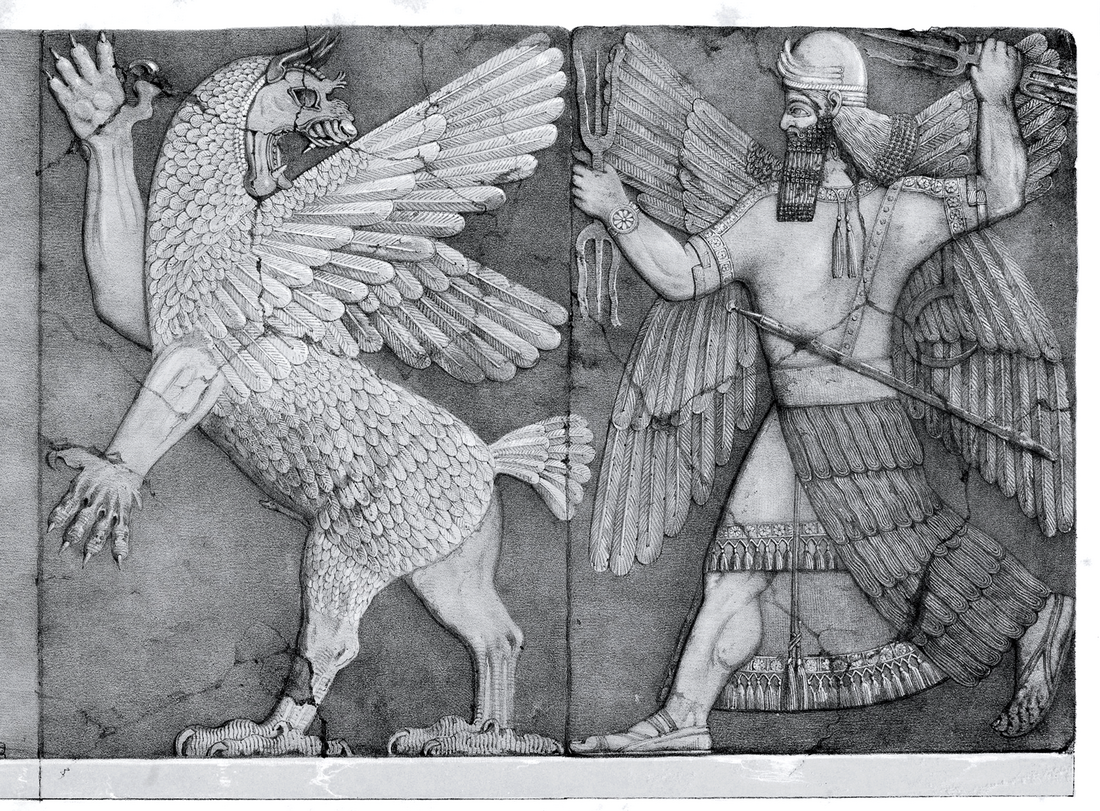Lamashtu
Mesopotamian mythological figure From Wikipedia, the free encyclopedia
In Mesopotamian mythology, Lamashtu (𒀭𒈕𒈨; Akkadian dLa-maš-tu; Sumerian Dimme dDim3-me or Kamadme[2]) is a demonic Mesopotamian deity with the "head of a lion, the teeth of a donkey, naked breasts, a hairy body, hands stained (with blood?), long fingers and fingernails, and the feet of Anzû".[3] She was believed to feed on the blood of human infants[3] and was widely blamed as the cause of miscarriages and cot deaths.[3]
This article needs additional citations for verification. (September 2010) |

Although Lamashtu has traditionally been identified as a demoness,[4] the fact that she could cause evil on her own without the permission of other deities strongly indicates that she was seen as a goddess in her own right.[3] Mesopotamian peoples protected against her using amulets and talismans.[3] She was believed to ride in her boat on the river of the underworld[3] and she was associated with donkeys.[3] She was believed to be the daughter of An.[3]
Mythology
Summarize
Perspective
Lamashtu's father was the Sky god Anu.[5] Unlike many other usual demonic figures and depictions in Mesopotamian lore, Lamashtu was said to act in malevolence of her own accord, rather than at the gods' instructions. Along with this her name was written together with the cuneiform determinative indicating deity.[6] This means she was a goddess or a demigoddess in her own right.[7]
She bore seven names and was described as seven witches in incantations. Her evil deeds included (but were not limited to): slaying children, unborns, and neonates; causing harm to mothers and expectant mothers; eating men and drinking their blood; disturbing sleep; bringing nightmares; killing foliage; infesting rivers and lakes; and being a bringer of disease, sickness, and death.[7]
Pazuzu, a god or demon, was invoked to protect birthing mothers and infants against Lamashtu's malevolence, usually on amulets and statues. Although Pazuzu was said to be bringer of famine and drought, he was also invoked against evil for protection, and against plague, but he was primarily and popularly invoked against his fierce, malicious rival Lamashtu.[8]
Incantation against Lamashtu:
Great is the daughter of Heaven who tortures babies
Her hand is a net, her embrace is death
She is cruel, raging, angry, predatory
A runner, a thief is the daughter of Heaven
She touches the bellies of women in labour
She pulls out the pregnant women's baby
The daughter of Heaven is one of the Gods, her brothers
With no child of her own.
Her head is a lion's head
Her body is a donkey's body
She roars like a lion
She constantly howls like a demon-dog.[9]
In another incantation against her, she appears to be identified with Inanna:
Lamash, daughter of Anu
Whose name has been uttered by the gods
Innin(Inanna), queen of queens
Lamashtu, O great lady
Who seizes the painful Asakku
Overwhelming the Alû
Come not nigh what belongeth to the man
Be conjured by Heaven
Be conjured by the Earth
Be conjured by Enlil
Be conjured by Ea.[10]
In modern culture
- Lamashtu is a demon lord and the goddess of monsters, called the Mother of Beasts and Mistress of Insanity, in the role-playing game setting Pathfinder.
- Lamashtu is the title of a 2015 audiobook by Paul E Cooley.
- Lamashtu appears as the antagonist in the 2017 film Still/Born.
- The song "lamashtu" by Necrophobic on their 2018 album Mark of the Necrogram is named for Lamashtu.
- Lamashtu is depicted on the Ankaran Sarcophagus in the videogame Vampire: The Masquerade – Bloodlines.
- Lamashtu appears as the demon who possesses two young girls in The Exorcist: Believer.
- Lamashtu is worshipped in the 2022 Spanish horror film Venus.
- Lamashtu is summoned in a 2025 Saturday Night Live sketch featuring Lady Gaga.
- In Constantine (TV series) directed by Daniel Cerone and David S. Goyer Lamashtu appeared in the 8th Episode ("The Saint of Last Resorts"). In that episode protagonist John Constantine invoked Pazuzu to fight against it. The episode was written by Carly Wray and directed by T. J. Scott.
Ritual
An Akkadian incantation and ritual against Lamashtu is edited in Texte aus der Umwelt des Alten Testaments vol. 2 (1988)[11] It is glossed as an "incantation to dispel lasting fever and Lamashtu". The prescribed ritual involves a Lamashtu figurine. A sacrifice of bread must be placed before the figurine and water must be poured over it. A black dog must be made to carry the figurine. Then it is placed near the head of the sick child for three days, with the heart of a piglet placed in its mouth. The incantation must be recited three times a day, besides further food sacrifices. At dusk on the third day, the figurine is taken outdoors and buried near the wall.
See also
References
Sources
External links
Wikiwand - on
Seamless Wikipedia browsing. On steroids.





